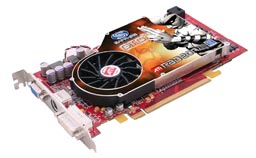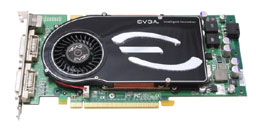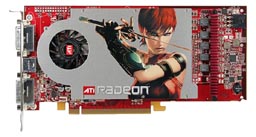Mid-Range to High-End Buyer's Guide, January 2006
by Jarred Walton on January 2, 2006 1:00 AM EST- Posted in
- Guides
Graphics Recommendations
All of the motherboards are obviously PCI Express systems, so we have mid-range and high-end recommendations. The problem is that we also get the NVIDIA vs. ATI perspective, and in many areas, there is no right answer. We prefer the SLI configurations to CrossFire configurations, as the pass-through cable just makes for increased cable clutter. Realistically, though, we feel most people are best served by getting a single graphics card within their budget constraints, so unless your budget is more than $700, we see no need to consider multiple GPUs. (Unless, of course, you're planning on running four displays from one system.)
Mid-Range Graphics Recommendation: eVGA GeForce 6800 GS 256MB
Price: $196 shipped (Retail)
Some people will say that even $200 is too much for a "Mid-Range" graphics card. If you really don't care about 3D performance, you can downgrade to just about any PCI Express graphics card and be happy. I look at recommendations within a price range, and $200 is a "Mid-Range" graphics card to me. It just so happens that there is a couple if good recommendations right at this price point, which helps justify the cost. The 6800 GS provides power roughly equal to last year's 6800 GT cards at a price about $100 lower. (Overclocking the cards can often come near 6800 Ultra performance levels, if you're interested in giving that a try.) Two of these cards end up being about equal to a 7800 GTX - faster in some instances and slower in others - so the upgrade potential is there. Honestly, though, we don't know how long the 6800 GS cards will be around, so plan on running one card and if you're looking to spend more than $200, upgrade to a faster single card.
Mid-Range Graphics Alternative: Sapphire Radeon X800GTO2 256MB
Price: $206 shipped (Retail)
And representing the red team, we have a similarly priced card in the form of the Sapphire X800 GTO2. Unlocking the full 16 pixel pipelines and overclocking the cores on these Sapphire cards has resulted in a very high success rate, though even at stock speeds, you get a very fast card. You miss out on SM3.0 support, which might become an issue in the future, but most of the SM3.0 enabled games seem to demand a bit more computational power than what last generation video cards can supply anyway. We don't like CrossFire for the X800 ATI platform for a number of reasons (1600x1200@60Hz is the big one), but as we've already mentioned, SLI/CF for sub-$700 GPU configurations doesn't make a lot of sense anyway. Like the 6800 GS, the X800 GTO/GTO2 cards may not be around much longer anyway. Still, X850 Pro (XT with overclocking) performance for $200 isn't a bad parting gift from ATI's R4xx series.
High-End Graphics Recommendation: eVGA 256-P2-N516 GeForce 7800GT 256MB
Price: $304 shipped (Retail)
The prices of 7800GT cards have dropped over $100 since launch, putting them below even most 6800 GT cards while providing more power than a 6800 Ultra. These cards can run almost any current game at resolutions up to 1920x1200, though you may have to tweak the detail levels a bit for optimal performance. The 6800 GT was an extremely popular card from NVIDIA last year, and the 7800 GT looks to surpass it in just about every area: lower street price, higher performance, better availability, and even slightly lower temperatures. At just over $300, this card strikes a great balance between price, performance, and features. High-end gamers can look towards the 7800 GTX 256MB and 512MB cards if they need even more power, and we would go that route before moving to SLI. Finding a 512MB GTX in stock is still difficult, unfortunately, though if you have $700 to blow it can be done.
High-End Graphics Alternative: Connect3D Radeon X1800XL 256MB
Price: $328 shipped (Retail)
Unlike the Mid-Range GPU recommendation, the ATI X1800XL is definitely an alternative as opposed to an equal recommendation to the 7800 GT. A higher price combined with generally slightly slower performance in our tests makes the NVIDIA card the winner. The SLI vs. CF comparison also favors the NVIDIA card, as you would need to buy a more expensive CF X1800 Master card for the X1800XL. Outside of the dual-GPU configurations, though, it's still relatively close, so those of you who inherently prefer ATI won't be missing out on much other than $25. Performance is very good in all current games with the X1800XL, and like the 7800 GT, prices have dropped over $100 since the cards first launched a couple of months ago. Looking to the higher-end ATI cards, ATI has the advantage. The X1800XT comes with 512MB of 1.5 GHz DDR3 memory, allowing it to surpass the 7800 GTX 256MB in the majority of tests. While the 7800 GTX 512MB does reign supreme as the fastest card, it also is very difficult to find, and the X1800XT is now readily available for about $495. It's definitely not cheap, but it's only $40 more than the cheapest GTX 256MB and usually more than 10% faster.
Graphics Recap
Given the number of choices for graphics, combined with the fact that needs can range from "just make Windows work" to "make FEAR run at 100 FPS!", we felt a quick rundown of the various price categories with a good recommendation for each was in order. That's what the above table represents, though we didn't go below the $100 price point for this level of system. The X1600 Pro from MSI represents an interesting value, which is good news. Although usually faster than the 6600GT and X700Pro, the X1600 appeared doomed for failure with the original MSRP of $200. A 500 MHz core with 12 pixel pipelines combined with 256MB of 800 MHz RAM for $134 is much more palatable, though, and it gets our recommendation for the lower cost mid-range or higher cost low-end graphics cards.
All of the motherboards are obviously PCI Express systems, so we have mid-range and high-end recommendations. The problem is that we also get the NVIDIA vs. ATI perspective, and in many areas, there is no right answer. We prefer the SLI configurations to CrossFire configurations, as the pass-through cable just makes for increased cable clutter. Realistically, though, we feel most people are best served by getting a single graphics card within their budget constraints, so unless your budget is more than $700, we see no need to consider multiple GPUs. (Unless, of course, you're planning on running four displays from one system.)
Mid-Range Graphics Recommendation: eVGA GeForce 6800 GS 256MB
Price: $196 shipped (Retail)
Some people will say that even $200 is too much for a "Mid-Range" graphics card. If you really don't care about 3D performance, you can downgrade to just about any PCI Express graphics card and be happy. I look at recommendations within a price range, and $200 is a "Mid-Range" graphics card to me. It just so happens that there is a couple if good recommendations right at this price point, which helps justify the cost. The 6800 GS provides power roughly equal to last year's 6800 GT cards at a price about $100 lower. (Overclocking the cards can often come near 6800 Ultra performance levels, if you're interested in giving that a try.) Two of these cards end up being about equal to a 7800 GTX - faster in some instances and slower in others - so the upgrade potential is there. Honestly, though, we don't know how long the 6800 GS cards will be around, so plan on running one card and if you're looking to spend more than $200, upgrade to a faster single card.
Mid-Range Graphics Alternative: Sapphire Radeon X800GTO2 256MB
Price: $206 shipped (Retail)
And representing the red team, we have a similarly priced card in the form of the Sapphire X800 GTO2. Unlocking the full 16 pixel pipelines and overclocking the cores on these Sapphire cards has resulted in a very high success rate, though even at stock speeds, you get a very fast card. You miss out on SM3.0 support, which might become an issue in the future, but most of the SM3.0 enabled games seem to demand a bit more computational power than what last generation video cards can supply anyway. We don't like CrossFire for the X800 ATI platform for a number of reasons (1600x1200@60Hz is the big one), but as we've already mentioned, SLI/CF for sub-$700 GPU configurations doesn't make a lot of sense anyway. Like the 6800 GS, the X800 GTO/GTO2 cards may not be around much longer anyway. Still, X850 Pro (XT with overclocking) performance for $200 isn't a bad parting gift from ATI's R4xx series.
High-End Graphics Recommendation: eVGA 256-P2-N516 GeForce 7800GT 256MB
Price: $304 shipped (Retail)
The prices of 7800GT cards have dropped over $100 since launch, putting them below even most 6800 GT cards while providing more power than a 6800 Ultra. These cards can run almost any current game at resolutions up to 1920x1200, though you may have to tweak the detail levels a bit for optimal performance. The 6800 GT was an extremely popular card from NVIDIA last year, and the 7800 GT looks to surpass it in just about every area: lower street price, higher performance, better availability, and even slightly lower temperatures. At just over $300, this card strikes a great balance between price, performance, and features. High-end gamers can look towards the 7800 GTX 256MB and 512MB cards if they need even more power, and we would go that route before moving to SLI. Finding a 512MB GTX in stock is still difficult, unfortunately, though if you have $700 to blow it can be done.
High-End Graphics Alternative: Connect3D Radeon X1800XL 256MB
Price: $328 shipped (Retail)
Unlike the Mid-Range GPU recommendation, the ATI X1800XL is definitely an alternative as opposed to an equal recommendation to the 7800 GT. A higher price combined with generally slightly slower performance in our tests makes the NVIDIA card the winner. The SLI vs. CF comparison also favors the NVIDIA card, as you would need to buy a more expensive CF X1800 Master card for the X1800XL. Outside of the dual-GPU configurations, though, it's still relatively close, so those of you who inherently prefer ATI won't be missing out on much other than $25. Performance is very good in all current games with the X1800XL, and like the 7800 GT, prices have dropped over $100 since the cards first launched a couple of months ago. Looking to the higher-end ATI cards, ATI has the advantage. The X1800XT comes with 512MB of 1.5 GHz DDR3 memory, allowing it to surpass the 7800 GTX 256MB in the majority of tests. While the 7800 GTX 512MB does reign supreme as the fastest card, it also is very difficult to find, and the X1800XT is now readily available for about $495. It's definitely not cheap, but it's only $40 more than the cheapest GTX 256MB and usually more than 10% faster.
Graphics Recap
| Graphics Cards | ||
| Class | Model | Price |
| Budget | Sapphire Radeon X700 Pro 128MB | 120 |
| Budget | MSI Radeon X1600 Pro 256MB | 134 |
| Budget | eVGA GeForce 6600GT 128MB | 140 |
| Mid-Range | eVGA GeForce 6800 GS 256MB | 196 |
| Mid-Range | Sapphire Radeon X800GTO2 256MB | 206 |
| High-End | eVGA 256-P2-N516 Geforce 7800GT 256MB | 304 |
| High-End | Connect3D Radeon X1800XL 256MB | 328 |
| Ultra-High | eVGA GeForce 7800GTX 256MB | 448 |
| Ultra-High | Sapphire Radeon X1800XT 512MB | 487 |
| Ultra-High | GeForce 7800GTX 512MB (Pre-Order) | 699 |
Given the number of choices for graphics, combined with the fact that needs can range from "just make Windows work" to "make FEAR run at 100 FPS!", we felt a quick rundown of the various price categories with a good recommendation for each was in order. That's what the above table represents, though we didn't go below the $100 price point for this level of system. The X1600 Pro from MSI represents an interesting value, which is good news. Although usually faster than the 6600GT and X700Pro, the X1600 appeared doomed for failure with the original MSRP of $200. A 500 MHz core with 12 pixel pipelines combined with 256MB of 800 MHz RAM for $134 is much more palatable, though, and it gets our recommendation for the lower cost mid-range or higher cost low-end graphics cards.














67 Comments
View All Comments
Reldan - Wednesday, January 18, 2006 - link
As awesome as a 30" Apple Cinema is, have you considered the prospects of using a much larger HDTV? I use a 65" HP MD6580n, and it's the best monitor I've ever owned bar none. It's ridiculously huge but the picture remains sharp at 1920 X 1080, especially with the wobulation tech which removes most if not all of the screen door effect you might have with a set this size.I know that a big deal is being made about these awesome 30" monitors from Apple and now Dell, but HDTV technology has progressed to the point where in my mind there is no better choice for high-end gaming.
gman003 - Monday, January 9, 2006 - link
So my question to everyone is, is 2GB really worth the $100 upgrade compared to 1GB. Can you get decent memory to overclock with at 2GB? If I was planning to run a DFI LanParty Ultra-D board, would I really use the same 2GB memory Jarrod recommended for the HighEnd system for my overclocking purposes?I guess the biggest thing that struck me from the article was that you could probably get away using an old ATA133 7200rpm Drive as long as you have 2GB of memory. Should I really sacrifice not upgrading my hard drive so that I can have 2GB of memory?
flamethrower - Monday, January 9, 2006 - link
You can check out the following article. The gist is that you get better loading times with more ram, the article will show you the results from changing various ram amounts in a high-end setup.http://www.tomshardware.com/2005/12/13/how_much_ra...">http://www.tomshardware.com/2005/12/13/how_much_ra...
I apologize for linking to an outside site, but I don't think the content is available on Anandtech. Maybe you guys should think about (or point me to) your article on this topic.
Finally, you wanted to know "Is it worth it?" Only you can answer this question. My personal opinion is that it is, but you might be building a budget system and not have the budget for 2GB RAM. As Jarred points out: "You are not going to notice 60 fps vs. 63, but you are going to notice a 38 sec loading time vs 63" or something like that.
gman003 - Monday, January 9, 2006 - link
Ok, maybe I will clarify:I am building a budget $800 system and want to know what will give me better performance.
Should I stay with 2 gigs of ram and not upgrade my old ATA 133 7200rpm 200GB drive or get 1 gig of ram and upgrade my hard drive to a new 3.0GB SATA 7200rpm 250GB.
Yeah, I've read that article too. But I mean, c'mon? With 2 gigs of ram, you don't notice any significant advantages in like 9 out of 10 tests with the only significant thing being load times/heavy multitasking. I don't know if I can justify $100 to load World of Warcraft 30 seconds sooner when I'm more concerned with FPS, video encoding, and large file transfers. IMO I think the the $100 could be spent on a HD or even better, a cooler mobo and/or case for the system.
JarredWalton - Tuesday, January 10, 2006 - link
Generally speaking, for games you want GPU speed first, and CPU speed second. RAM speed and quanitity as well as HDDs are distant fourth/fifth place finishes. Once you've got the others at a reasonable speed, though - where diminishing returns kicks in - then you should start looking at upgrading the RAM and then the HDD. That's my take, anyway.flamethrower - Sunday, January 8, 2006 - link
What do you guys think about an Opteron 165 or 170 instead of the X2 4200+? The 170 and the 4200+ are about the same price.JarredWalton - Monday, January 9, 2006 - link
If you're willing to overclock, there's no real reason to go any higher than the 165/170 Opty or the X2 3800+. I've got a 165 that OCs to around 2.5 GHz with the stock HSF. I'm going to try a few changes to the system to see if I can go further than 2.5 GHz, but there's really not that great of a need.pg55555 - Thursday, January 5, 2006 - link
If you are looking for performance, I think RAID 0 is a valid alternative that is often forgoten in the guidesJarredWalton - Saturday, January 7, 2006 - link
I've used RAID 0 and found it to largely be a waste of time and money. RAID 1 and 5 I can understand, but in terms of improving load times, running 2GB of RAM has done far more for me than running RAID 0. It's just a lot of hassle for negligible performance increases IMO.archcommus - Tuesday, January 3, 2006 - link
I was pretty definite that the Klipsch Ultra 5.1 has better sound quality and bass than the z-5500. Now that AT recommended the Logitech even for the high-end system, I'm not so sure.I really like my music and am in the market for a new 5.1 system. Should I go z-5500 or Klipsch ProMedia Ultra?